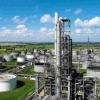In PHE, SS316 plates are observed corroded . It is seen that cooler uses cooling water with higher chloride content(250~350 ppm).PHE process side has corrosive liquid circulation at temperature range of 65~70 deg_C.Apart from this PHE, the rest of the PHEs are having same cooling water but process fluid temperature parameters are almost below 50 deg_C & no corrosion effects.
1) What are the causes for corrosion in specific case?
2) What type of corrosion is taking place?
3) What is the better type of M.O.C. for PHE in trouble?
4) What are the right plate packing method to avoid corrosion ???
Thanks & regards
|
|
Plate & Frame Heat Exchangers
Started by drdave, Mar 13 2005 04:19 AM
1 reply to this topic
Share this topic:
#1

Posted 13 March 2005 - 04:19 AM
#2

Posted 18 March 2005 - 07:00 AM
The corrosion type could be pitting corrosion. Pitting corrosion is a form of extremely localized attack that results in holes in the metal. These holes may be small or large in diameter, and their depth is in most cases larger than their diameter. Pits are sometimes isolated or so close together that they look like a rough surface.
Most pitting failures occur when austenitic stainless steels are exposed to chloride and chlorine containing solutions, especially under stagnant conditions. Chloride ions replace oxygen, hydroxide ions in the protective layer. The metal chloride is dissolute in water. The dissolution accelerates in the pit with high concentration of chloride.
The pitting corrosion occurs when temperature is higher than so-called "Pitting critical temperature". This temperature is depend of Mo content in alloy and chloride concentration. High Mo content gives better resistant for pitting.
Hope it may help.
Most pitting failures occur when austenitic stainless steels are exposed to chloride and chlorine containing solutions, especially under stagnant conditions. Chloride ions replace oxygen, hydroxide ions in the protective layer. The metal chloride is dissolute in water. The dissolution accelerates in the pit with high concentration of chloride.
The pitting corrosion occurs when temperature is higher than so-called "Pitting critical temperature". This temperature is depend of Mo content in alloy and chloride concentration. High Mo content gives better resistant for pitting.
Hope it may help.
Similar Topics
Heat Loss Calculation From Cylindrical Tan;Started by Guest_rasprocess2026_* , 23 Jul 2025 |
|

|
||
Steam Pressure In Heat ExchangerStarted by Guest_mvanrijnbach_* , 15 Apr 2025 |
|

|
||
Heat Exchanger Steam FlowStarted by Guest_aliebrahem17_* , 25 Nov 2024 |
|

|
||
Discussion - Predict Storage Tank Heat Transfer Precisely By Jimmy D KStarted by Guest_raj shekhar_* , 25 Mar 2025 |
|

|
||
Cross Over Temperature In Countercurrent Heat ExchangerStarted by Guest_panoska_* , 18 Feb 2025 |
|

|

 FB
FB






